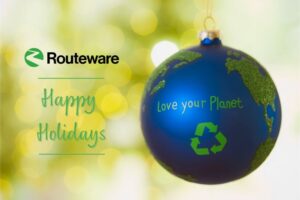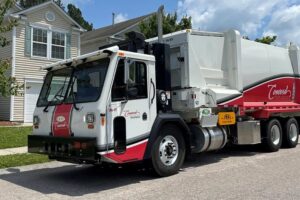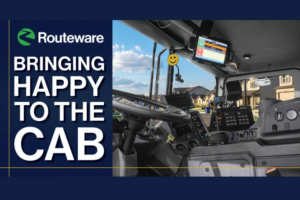When digital options first began to emerge for municipal waste hauling services, the expectation was that they would augment human interactions and provide a convenient alternative for a younger demographic. There was talk of offloading resource-consuming transactions to self-serve channels and allowing self-service requests to come in during non-business hours. Now, even your grandmother is carrying a smart phone, and digital has gone from the backup channel to the preferred choice for most customers.
Driven by tight budgets, personnel shortages, and a desire to meet residents where they are, government entities from municipalities to nations are transforming to digital communication channels. The benefits are many: Increased efficiencies, data-driven decision making, greater customer and employee engagement, and gains in sustainability.
In this guide, we will outline the case for digital transformation, provide some planning tips, discuss some initial challenges in digital transformation and suggest an initial menu of digital projects.
The Case for Digital Transformation
There are plenty of reasons municipalities are adopting digital that can be built in your digital transformation plan, including consumer demand, productivity and cost savings, a more efficient fleet, attracting and retaining employees, and sustainability. Combined, these benefits create the basis for potentially explosive growth, driving demand and delight higher as your customers become more familiar with your new communication channels.
Consumer Demand for Digital Communication
Digital tools and mobile applications have been fully adopted by every generation, with the possible exception of seniors in their 70s and older. Still, everyone has a story of an older relative engaging on social media and trying out new features on their smart phone. The pandemic accelerated the use of digital tools as people learned new ways of requesting services, interacting, and getting information without having to leave the safety of their home.
Municipal residents are not only more comfortable using mobile and online tools, they’ve embraced the benefits: Saving time and travel, contact-less services, and doing chores on their own time rather than waiting to speak to a customer service representative. Younger generations demand digital tools for all their services and are quick to shun options they consider “old school.” But Boomers and Gen X are not far behind, and as time passes, the demand for digital communication will continue to rise.
Even when consumers have no choice of solid waste services, impatience, complaints, and frustration can run high if they feel their municipality isn’t up to date in their offerings, creating more stress for your staff and potentially creating more issues with the same account down the line.
Productivity and Cost Savings
Digital waste management technology provides many opportunities to increase efficiency while at the same time delivering a higher level of service. Waste management is increasing productivity and decreasing costs with in-truck tools that increase collection accuracy, including in-cab tablets and on-board video cameras; fleet automation to optimize route design; and apps for customer self-service and waste & recycling education.
Municipalities from Michigan to Kentucky to Austin, Texas have shared metrics with Routeware that illustrate how the tools provided in waste management digital transformation provide significant results in their communities. This includes faster route completion times, better route balancing, and reductions in waste sent to landfills. Most of these results have measurable cost-saving implications.
When municipalities only look at the expense side of digitization, the picture is incomplete. Every digitization initiative should be evaluated in the context of increased productivity, service, and efficiency. More often than not, waste management companies post-digital transformation will see their initial expense paid for by these benefits within a year or two of their implementation.
A More Efficient Fleet
Growing communities continually challenge the flexibility of solid waste collection. For one thing, cities don’t grow evenly. Some neighborhoods are booming, while others age quietly. And still others are filling in with new businesses and housing types. Every change means added stops and sometimes altered logistics requiring different truck types. It’s simply too time consuming to optimize solid waste routes with paper maps, making a digital route optimization solution for waste management almost necessary for continued growth.
Municipalities that use digital route optimization are able to respond to the changing dynamics of their communities while delivering higher service levels at a lower cost. Lexington, Kentucky, a Routeware customer, optimized 90 routes in a fraction of the time as their previous manual method, saving driver resources and overtime.
You may foresee drivers being a bit resistant to the technology-oriented changes that come with digital transformation, but we find that drivers tend to enjoy the changes as soon as they’re used to them, as it saves drivers valuable time with each and every stop.
Attracting and Retaining Employees
Just as consumers are demanding digital tools for accessing municipal services, employees evaluate potential job opportunities in part based on the kind of resources they’re given to work with. Solid waste team members tend to choose employers that provide them with modern digital tools.
In an extremely tight job market experiencing a severe driver shortage, companies are increasing pay and offering attractive bonuses to lure experienced team members. Municipalities that are unable to keep up with the compensation game can offer benefits that improve work life for their employees. Modern digital tools help employees communicate, get up to speed faster, and stay safe on their routes.
With that being said, a common challenge in digital transformation in waste management is getting your current employees up to proficiency with the new tools you’re handing them. Change can be scary for employees, so make sure to take the time to acknowledge their needs in the digital transformation process, or risk losing employees that are valuable to the company.
Digital Drives Sustainability
Climate change and sustainability are major topics for waste management departments. The role that trucking and landfill emissions play in greenhouse gas emissions has been well established. Municipalities are being asked to play their part by setting and meeting carbon-reduction goals.
Route optimization software and in-cab digital solutions help make sure fleets reduce their time on the road, with direct impact on emissions. A fleet that’s in constant communication makes better decisions on the fly and is able to support each other to complete routes most efficiently with the highest service standards.
Your Waste Management Digital Transformation Plan: Getting Started
Many municipalities have already started adding digital services, but often this is done in a one-off fashion, either by addressing a specific pain point or by taking advantage of an easy, low-cost solution that came to the attention of a decision maker. With a world of attractive digital options, today’s IT teams need to be much more strategic in how they implement new digital solutions. That’s why they’re building their plans around discrete activities that will show quick and tangible results, with a focus centered on the ROI of a project rather than the complete digital transformation that could improve metrics across the board.
In “Digital by Default: A Guide to Transforming Government,” McKinsey Center for Government suggests a two-dimensional framework for prioritizing digital transformation activities: Level of complaints and cost of the process. Priority items for digitization are those in the lower left quadrant. They’re the ones that consume a lot of resources and generate a lot of complaints, making these the first challenges in digital transformation to be solved if possible.
There are other ways to prioritize digital transformation projects. It’s valuable to have a standard methodology because demand for budget and IT resources will always exceed availability. By making your evaluation criteria transparent and engaging stakeholders in the decision making, you can move from plan to implementation much more quickly.
Situational Assessment
You’ll need data to plan and evaluate the success of digitization projects. This also helps you identify your next incremental step. Your situational assessment should start with existing data. By carefully examining each point along the solid waste path, you’ll discover data points that help tell a story.
GPS on trucks and RFID tags on recycling carts will paint a picture of your fleet’s efficiency. You may have more insight than you think into potential problem areas if you zoom out from day-to-day issues. Data about customer concerns, questions, and complaints can come from your website and call center logs.
You’ll also want to engage customer service personnel to validate your insights, but be sure they’re responding to the data as well so you don’t get distracted by outdated assumptions.
An advantage of digital transformation is the level to which it will enhance data collection and the ease of reporting results. Enhanced measurement leads to better decision making and outcomes. Since digital transformation is an ongoing process, each initiative builds on the ones before to enhance efficiency and data clarity.
Goal Setting
Digital means better data, and better data means more refined goal setting. You can move faster toward implementation when goals are clearly stated and substantiated, providing common understanding for agreement. Faster implementation means the department, and the people you serve, begin seeing benefits sooner.
As you set goals for your digital transformation, consider the SMART rubric. SMART goals are specific, measurable, achievable, relevant, and time-bound. (University of California provides a helpful how-to guide.) Let’s take a look at an example, using recycling education, of how including the SMART rubric can help make a case for implementing digital tools:
Specific: So you want to improve recycling education by implementing an online search tool. But how do you know the tool is being used? A specific goal would be to look at the increase in your website users month-over-month, or you may look at the number of incorrectly recycled materials going down, which indicates that your users are taking in and using the information presented to them.
Measurable: Without a target measurement, even the slightest increase in website users would meet your goal. It’s important to put a stake in the ground. For example, you might decide you want to target a 20% increase in website users month-over-month.
Achievable: If you’ve never before implemented educational tools or interactive website features, it’s hard to know what kind of goal is realistic. If you don’t have historic information, benchmark data from other municipalities can help you identify an achievable goal. If a similarly-sized municipality was able to achieve a 25% growth in recycling, for example, that may be your benchmark, but be sure to benchmark from an organization that realistically reflects a similar situation to your own.
Relevant: Be sure the goal and your measurement is going to provide true insight into the real issue. Measuring decreased contamination or better recycling of specific materials can also support your digitization efforts.
Time-Bound: As indicated above, measurements are only valuable if they specify a goal and a time frame. An open-ended timeframe will leave stakeholders asking when they should expect to see results from digital investments. Goals that aren’t time-bound have no sense of urgency, so this helps to ensure that the goal stays on track for as long as the goal is relevant.
Solutions First: Four Problems Best Solved With Digital
Municipalities are typically not early adopters of digital, and while that can make you feel like you’re playing catch-up, it can also be used to your advantage. As we’ve outlined on previous pages, you can look to other organizations to learn from their successes and failures. Waste-specific solutions are now available that allow you to significantly shortcut development and customization timelines. That means you can get up and running in a fraction of the time.
Your prioritization of digital tools should start with the most pressing problems you need to solve. So let’s look at options through that lens:
1 – The Issue: Printing and Mailing Collection Calendars
The costs of printing, mailing, and even paper are on the rise. Your communications team is telling you that nobody reads or saves the annual calendar. And how does it look to mail paper to every address in the community, then have it (hopefully) end up in the recycle bin? When residents can access calendars and collection schedules online or via a mobile app, they know they’ll always have the information they need at their fingertips. Routeware’s calendar tool is a breeze to set up, and changes can be done in real-time without incurring any additional costs.
Digital calendar in action: Austin Resource Recovery in Texas saved $66,000 per year when they stopped printing and mailing paper calendars, which a report had shown only seven percent of customers were using anyway.
2- The Issue: Back Office Paper Shuffling
Keeping track of vehicle and equipment maintenance, as well as ongoing daily and weekly tasks in the office and shop, is no job for pen and paper. Teams love simple, app-based task managers that allow them to review their assignments for the day, check them off when complete, and add notes, right on their phones. Digital task management also keeps team members engaged in the work they’re meant to do rather than filling out paperwork or shuttling to and from the office.
Digital task management in action: A shared to-do list reduces unnecessary phone calls and e-mails to staff, increases accountability, and eliminates the need to store binders of paper maintenance logs. Digital task management also simplifies reporting and makes it easier to demonstrate compliance.
3 – The Issue: Recycling Contamination
Residents want to do recycling and composting right, but they’ll often make incorrect assumptions when packaging is confusing or guides are vague. This can lead to wishcycling and recycling contamination. Online and app-based digital tools provide searchable lists so residents can look up specific items and know exactly where to toss them.
Waste education in action: Many municipalities are using the 1-5-50 rule proposed by The Recycling Partnership. This easy-to-follow rule suggests that residents can absorb one idea from a billboard or radio message and five ideas that are presented in person. Long lists of 50 or more items for recycling are best provided on a searchable, online database.
4 – The Issue: Vehicle and Fuel Costs
Fleet automation and route optimization software target a number of budget-related issues. It’s difficult to invest in new initiatives when costs of fuel, personnel, and overtime continue to rise. Digital route optimization can be done more frequently in order to squeeze costs out of hauling. Onboard digital communications help the entire team support each other to make sure routes are completed accurately and on time.
Fleet automation and optimization in action: The next step in curbing greenhouse gas emissions is a carbon-free fleet. You can free up resources to invest in new vehicles by saving money now on a digital-forward fleet.
Learn more. Reduce contamination, lower costs and call volumes, and optimize your fleet while you engage your residents with the waste and recycling industry’s most trusted digital communication tools. Get Started.





